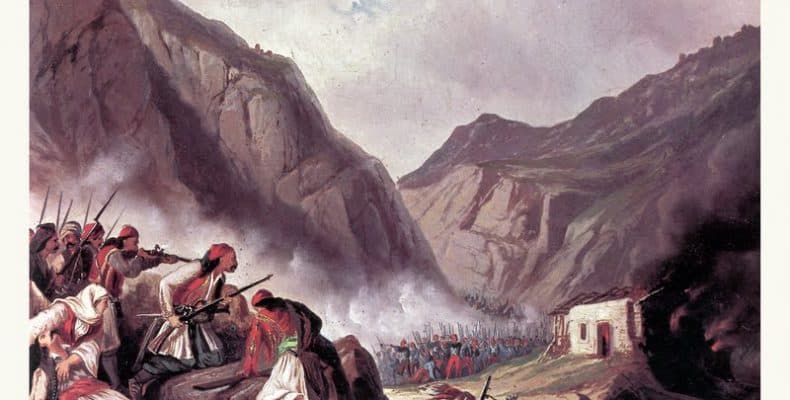The battle of Dervenakia is perhaps the most crucial battle of the Greek revolution. It took place in 1822 just one year after the revolution broke out and its success allowed the Greeks to continue their struggle for independence.
After the final defeat and death of Ali Pasha, the Ottoman forces under Hurshit Pasha, which had bivouaced in Larissa (a major Ottoman military center of the time), moved south to face the Greek Revolution with a powerful expeditionary force. The head of this army, consisting of about 30,000 troops, three-quarters of which were fighters, with many cannons and a multitude of pack animals, was Mahmud Pasha of Larissa, also known as Dramalis. The main objective of Dramalis was to retake the fortifications of Corinth, Nafplion, and Tripolis, in order to crush the Greek rebellion, Haini Zorbalik, as the Ottomans called it.
Dramalis, reaching Argos on July 12, with 30,000 men (of whom 24,000 were warriors), realized the desolation of the plain but decided to camp in order to occupy the Argos acropolis (Larissa), not wanting to go on to Tripoli, leaving behind enemy pockets. This decision also contributed to the fact that Larissa Castle was the first in the Peloponnese that offered resistance, making him believe that the Argives had sequestered their fortunes as well as many supplies. So the siege of the castle began the next day.
Day by day, however, the Ottoman army began to face serious food problems. Moreover, in the summer of 1822 it was very hot, in the spring there were few rainfalls and most wells and streams around Argos had dried up. Under these circumstances, Dramalis began to think seriously about halting the invasion and returning to Corinth.
On July 20th, the village of Miloi in the Argolis plain plain was the headquarters of the Greek fighters around whom the Greek irregulars had congregated. In the war council that followed, Kolokotronis proposed to encircle the Turks, and it was decided that the enemy would be trapped in the Argolis Plain, securing the Dervenakia narrows and placing strong defenses at Ahladokambos and Miloi.
At the same time, it was decided to raise the siege of Larissa castle, the defenders of which had begun to suffer from food and water shortages. Besides, the objective for which they had been defending the fortress had fully succeeded in keeping Dramalis in Argos, giving the required time for the recruitment and concentration of Greek troops. Thus, on the evening of July 23, some units were ordered to attack the besieged fortress from all sides. During the ensuing melee, properly alerted, the besieged left undisturbed and joined the rest of the Greek units.

On July 26, Dramalis decided to temporarily return to Corinth and moved to Dervenakia, a narrow defile that links the Argolis to the Corinthian plain. The main passage, based on General Kolokotroni’s plan, was guarded by Antonios Kolokotronis and about 1,500 men.
At the same time, Kolokotronis had placed chieftain Platoutas with about 800 men in Schinohori to guard the northwest exit of Argolida to Stymphalia, and Nikitaras and Papaflessas at Stefani and Aghonorri, with another 800 men to guard the third defile to Clenia.
On the day before the battle, Kolokotronis climbed the roof of a home and invigorated the fighters with a speech recounted by historian Phokakos. He began by saying, “Greeks, today we are born and today we will die for the salvation of our homeland and for ourselves” and continued:

“Today, the one of us who will be facing many, you will get a lot of spoils, and treasure of Ali Pasha you will share by the fez-full, and while the Turks have it, it is Christian money, as the tyrant of Epirus had taken it our brothers. The Holy God sent them to us, and it is our own chalice, and now I will see you all with the weapons of the Turks, with their horses, shining in their clothes, God is with us, … ”
The Turkish vanguard entered the narrow passage and when they arrived at the exit they were fired upon by the hidden Greeks. Few went towards the Kourtesa plain, while the main bulk retreated with great losses.
Since this passage was well guarded by the Greeks, the vanguard and the main body turned to the second nearby passage, that of Agios Sostis, east of the main crossing. This passage was very uphill and more difficult for infantry and animals, but the Turks found it defenseless and began to move towards Kourtesa while the unit of Antonis Kolokotronis flanked them. Meanwhile, the unit under Nikitaras and Papaflessas, at noon was alerted by smoke signals that Dramalis was moving towards Dervenakia. The unit regrouped, and marching swiftly it arrived in the afternoon at the summit to the east, above Agios Sostis, and saw the Turks going towards Kourtesa. Then they attacked the Turks immediately placing them between two fires, the new arrivals from the east and the west by the troops of A. Kolokotronis.
The battle lasted until late at night and the Turks sustained terrible losses in fighters, animals and materials. When it was dark, the Turk stopped and returned to Tiryns where they had set up camp. The losses of the Turks, on July 26, juxtaposing memoirs, other news and documents of the time, are estimated at around 2,500-3,000 dead and wounded.
Soon the destruction of Dramalis became a song and a legend in many Greek folk songs:
The Beys of Roumeli and the warriors of Morias
In Dervenakia lie as headless corpses …
The destruction of Dramalis’ army was completed in the Battle of Agionorion on July 28, 1822. Thus, Theodoros Kolokotronis was hailed as the organizer and principal factor of this victory that saved the Revolution and safeguarded freedom for modern Greece.


